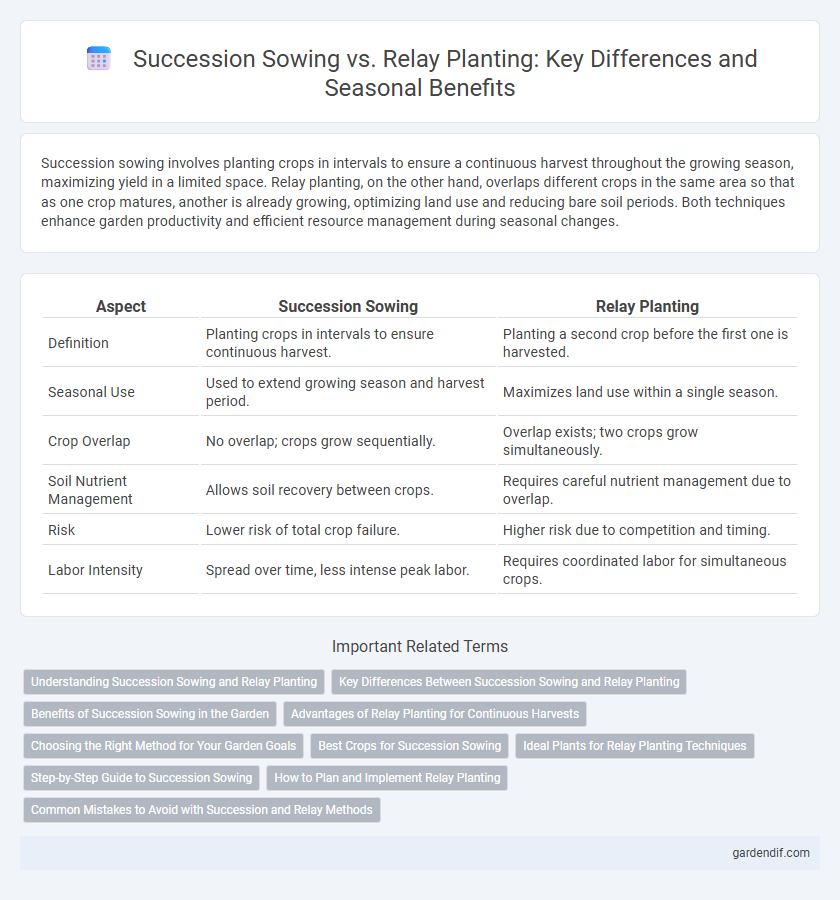
Succession Sowing vs Relay Planting Illustration
Succession sowing involves planting crops in intervals to ensure a continuous harvest throughout the growing season, maximizing yield in a limited space. Relay planting, on the other hand, overlaps different crops in the same area so that as one crop matures, another is already growing, optimizing land use and reducing bare soil periods. Both techniques enhance garden productivity and efficient resource management during seasonal changes.
Table of Comparison
| Aspect | Succession Sowing | Relay Planting |
|---|---|---|
| Definition | Planting crops in intervals to ensure continuous harvest. | Planting a second crop before the first one is harvested. |
| Seasonal Use | Used to extend growing season and harvest period. | Maximizes land use within a single season. |
| Crop Overlap | No overlap; crops grow sequentially. | Overlap exists; two crops grow simultaneously. |
| Soil Nutrient Management | Allows soil recovery between crops. | Requires careful nutrient management due to overlap. |
| Risk | Lower risk of total crop failure. | Higher risk due to competition and timing. |
| Labor Intensity | Spread over time, less intense peak labor. | Requires coordinated labor for simultaneous crops. |
Understanding Succession Sowing and Relay Planting
Succession sowing involves planting crops or seeds in intervals to ensure continuous harvest throughout the growing season, optimizing yield and resource use. Relay planting, on the other hand, is the practice of planting a second crop before the first crop is harvested, allowing overlapping growth periods and maximizing land productivity. Both techniques are essential for efficient seasonal crop management and extended harvesting schedules.
Key Differences Between Succession Sowing and Relay Planting
Succession sowing involves planting the same crop species at regular intervals to ensure continuous harvest, optimizing growth cycles and maximizing yield throughout the season. Relay planting, by contrast, overlaps two different crops in the same space, where the second crop is sown before the first is fully harvested, efficiently utilizing soil nutrients and space. Key differences include timing of sowing, crop variety used, and the primary goal: continuous production with succession sowing versus resource maximization and crop diversity with relay planting.
Benefits of Succession Sowing in the Garden
Succession sowing maximizes garden productivity by allowing continuous harvests through staggered planting of crops, ensuring fresh produce throughout the season. This method improves soil health by maintaining constant ground cover and reducing pest cycles. Gardeners benefit from efficient space utilization, as it enables multiple crop rotations within the same plot, increasing overall yield per square foot.
Advantages of Relay Planting for Continuous Harvests
Relay planting maximizes land use by overlapping crop growth cycles, ensuring continuous harvests without gaps between crops. This method reduces soil erosion and maintains soil fertility by keeping a living plant cover throughout the season. Farmers benefit from steady income and efficient resource use by staggering planting times and harvesting schedules.
Choosing the Right Method for Your Garden Goals
Succession sowing proves ideal for continuous harvests by planting new crops at intervals, maximizing garden productivity throughout the season. Relay planting enhances space efficiency by overlapping crops in the same bed, which suits gardeners aiming for year-round growth with limited area. Selecting between these methods depends on your garden goals, crop types, and seasonal climate to optimize yield and resource use.
Best Crops for Succession Sowing
Succession sowing maximizes garden yield by planting crops at intervals, ensuring continuous harvests. Best crops for succession sowing include fast-growing vegetables like spinach, lettuce, radishes, and carrots, which mature quickly and allow for multiple planting cycles. Cold-tolerant greens and root vegetables thrive in this method, extending the growing season effectively.
Ideal Plants for Relay Planting Techniques
Relay planting benefits crops with staggered maturity and tolerance to partial shading, such as lettuce, spinach, radishes, and bush beans. These plants thrive when new seeds are sown before the previous crop is fully harvested, ensuring continuous production and efficient use of garden space. Root vegetables like carrots and beets also adapt well to relay planting due to their varied germination times and growth rates.
Step-by-Step Guide to Succession Sowing
Succession sowing involves planting crops in intervals to ensure continuous harvest and maximize garden productivity throughout the season. Start by selecting fast-maturing seeds suited to your climate, prepare the soil thoroughly, and sow the first batch at the beginning of the planting season. Every two to three weeks, repeat the sowing process in designated rows or sections, ensuring a steady supply of fresh vegetables or herbs.
How to Plan and Implement Relay Planting
Plan relay planting by selecting crops with varying maturation periods to ensure continuous harvest throughout the season. Implement sowing in intervals, staggering planting dates every few weeks to replace harvested crops gradually. Monitor soil health and moisture levels consistently to optimize growth and prevent nutrient depletion during successive crop cycles.
Common Mistakes to Avoid with Succession and Relay Methods
Common mistakes in succession sowing include overcrowding seeds too soon, leading to poor air circulation and increased disease risk, while neglecting proper spacing can stunt growth. In relay planting, a frequent error is planting the next crop too early, causing competition for nutrients and light between overlapping plants. Both methods require careful timing and monitoring to avoid reduced yields and ensure continuous harvest throughout the season.
Succession Sowing vs Relay Planting Infographic

 gardendif.com
gardendif.com